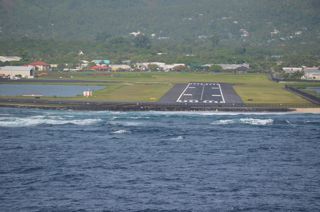Pago Pago (pronounced Pahngo Pahngo) is the capital city of American Samoa, a territory of the United States of America, where tourism, entertainment and tuna canning are the primary industries. From 1878 to 1951, it was coaling and repair station for the U.S. Navy. Pago Pago is a mixture of colourful semi-urban communities, a small town, tuna canneries (which provide employment for a third of the population of Tutuila) and a harbour surrounded by dramatic cliffs which plunge almost straight into the sea. Pago Pago is one of several small villages along the shore of the harbour and is located at the very back and inside of the embayment; however, because the name Pago Pago is associated with the harbour itself (the only significant port of call in America Samoa), Pago Pago is now generally applied to the whole harbour area, the town and the village.
A beautiful sail in under sunny skies, pictures here include the one runway airport (two flights per week from Honolulu), the flower pot islands and the Governor's House which is also known as the White House.
Another great tour and our last formal tour from the shore excursions office of Holland America, overall great tours providing us with in-depth and informative experiences of all the incredible cities and ports on this Grand Asia and Australian adventure. Today we had a ride in a funky local bus with natural air conditioning - complete with boom box with local sounds. We drove through some of the most interesting landmarks on this island, stoping at incredible vistas along the way. The church built in the 1800s has a most incredible sandalwood ceiling (here is a picture of part of this ceiling).
With Tommy (our guide)
Our Driver...
After lunch on the ship we headed over to The Sadie Thompson Restaurant. This old wooden building stands as a literary landmark to one of Tutuila’s (village next to Pago Pago) most famous visitors. W. Somerset Maugham stayed in the house during a measles epidemic in the early 20th century and was inspired to write his short story Rain.
Tip or comment of the day. Did you know that the Pacific Ocean contains more than 30,000 islands: their total area however amounts to only one quarter of one percent of the Ocean’s surface area. These Oceanic islands, collectively called Oceania, are the tops of mountains built up from the ocean basin by extruding molten rock. The mountains that remain submerged are called seamounts. In many areas, particularly the South Pacific, the land features above the sea surface are accretions of shell material, also called Coral Reefs.






































No comments:
Post a Comment